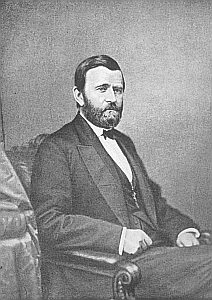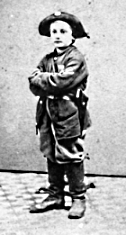Ulysses S. Grant was born on April 27, 1822 at Point Pleasant, Ohio. Point Pleasant is a community east of Cincinnati on the Ohio River. Grant’s father Jesse, was a tanner.
- When Grant arrived at West Point he found his appointment was in the name of Ulysses S. Grant. Grant’s parents named him Hiram Ulysses Grant. Grant never bothered to change the clerical error and was known as Ulysses S. Grant. Later, Grant was called “Unconditional Surrender Grant” after Confederate Simon Boliver Buckner surrendered Fort Donelson to him. Grant was also often called Sam Grant.
- While a cadet at West Point, Ulysses S. Grant was known as an exceptional horseman. Grant did not stand out as having exceptional talents in anything else while at West Point.
- Ulysses S. Grant wanted a commission in the cavalry when he finished at West Point. Instead, Grant wound up in the infantry because the cavalry had no vacancies. Grant was a horseman, and this assignment to the infantry must have been a disappointment for him.
- Ulysses S. Grant served with generals Zachary Taylor and Winfield Scott during the Mexican War.
- After the Mexican War, Ulysses S. Grant was stationed in California. He was without his wife and children, and very bored. Grant took to excessive drinking. He resigned his commission in 1854 and his resignation was accepted by the United States Secretary of War. The Secretary of War accepting Grant’s resignation from the United States Army was Jefferson Davis. Davis was the future president of the Confederate States of America.
- Grant’s favorite horse during the Civil War was Cincinnati. An admirer gave Cincinnati to Grant after the battle of Chattanooga. Cincinnati was seldom ridden by anyone other than Grant. One notable exception being President Abraham Lincoln, when Lincoln last visited City Point, Virginia. Other horses Grant had in the Civil War were; Jack, Fox, and Kangaroo. Kangaroo was left on the Shiloh battlefield by the Confederates. This horse was described as ugly and raw-boned. Grant however, having an eye for horses, knew that Kangaroo was a thoroughbred. After becoming a Yankee horse, Kangaroo got rest and care and he became a fine horse.
- Ely Samuel Parker was a Seneca Indian, a son of a famous Seneca chief, and also a Union officer. He first studied law but was refused admission to the bar because he was not a citizen. Parker graduated from Rensselaer as an engineer. In 1857, Ely Parker was working in Galena, Illinois where he became a friend of a store clerk named Sam Grant. Sam Grant, was Ulysses S. Grant and during the Civil War Ely Parker became General Ulysses S. Grant’s military secretary. Ely Parker’s penmanship was exceptional. When Lee surrendered to Grant at Appomattox Court House, Ely Parker transcribed the official copies of the surrender documents.
- Ulysses S. Grant never swore. His explanation for this:
“Well, somehow or another, I never learned to swear, when a boy I seemed to have an aversion to it, and when I became a man I saw the folly of it. I have always noticed, too, that swearing helps to rouse a man’s anger; and when a man flies into a passion his adversary who keeps cool always gets the better of him. In fact, I could never see the use of swearing. I think it is the case with many people who swear excessively that it is mere habit, and that they do not mean to be profane; but, to say the least, it is a great waste of time.”
- On April 14, 1865 Abraham Lincoln’s day was spent visiting with callers and attending a Cabinet meeting, which included General Grant. Lincoln explained to General Grant that he was having a recurring dream about a ship “moving with great rapidity toward a dark and indefinite shore.” Now that the Civil War was over, topics of discussion during the Cabinet meeting included the problems of reconstruction, and the treatment of Confederate leaders. That evening, the Lincolns went to Ford’s Theater to see the play “Our American Cousin.” While enjoying the play at Ford’s Theater Lincoln was shot by assassin John Wilkes Booth.
- After the Civil War, Ulysses S. Grant became an author, Secretary of War under President Johnson, and in 1868 became President of the United States. Grant served two terms as president.
- Ulysses S. Grant finished his two-volume autobiography; Personal Memoirs of U. S. Grant, only days before he died of throat cancer in 1885. Grant’s memoirs were published by Mark Twain’s firm and 300,000 copies were sold. These sales earned $450,000 for Grant’s widow, Julia. Grant’s autobiography is thought to be one of the best autobiographies written in the English language.

